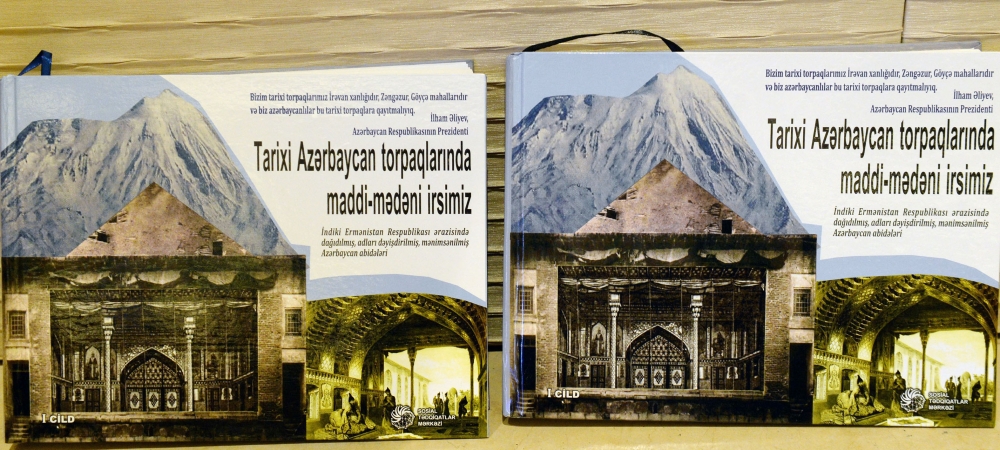

Sosial Tədqiqatlar Mərkəzi tərəfindən təşkil edilən "Tarixi Azərbaycan torpaqlarında maddi-mənəvi irsimiz: İrəvandan Zəngəzuradək" kitabının təqdimat mərasimi keçirilib.
Sosial Tədqiqatlar Mərkəzi tərəfindən ərsəyə gətirilən kitabda tarixi və geosiyasi vəziyyət, Cənubi Qafqazın erməniləşdirilməsi siyasətinə baxışa yer verilib. XIX əsrin əvvəllərində Qarabağ xanlığı ilə Rusiya arasında imzalanan Kürəkçay müqaviləsi, daha sonra isə Rusiya və İran dövlətləri arasında bağlanan Gülüstan və Türkmənçay müqavilələrindən sonra Azərbaycan torpaqlarına ermənilərin kütləvi köçürülməsi siyasəti həyata keçirilib. Bölgənin erməniləşdiriməsi siyasətinin əsas tutulması ilə buna paralel şəkildə tarixi Azərbaycan torpaqları olan İrəvan, Göyçə, Zəngəzur və Zəngibasar bölgəsində yaşayan azərbaycanlıların öz tarixi yurdlarından deportasiyası və soyqırımına start verilib.
Tarixdə ilk erməni dövləti – 1918-ci il mayın 28-də keçmiş İrəvan xanlığının ərazisində yaradılıb. Ermənistan adlanan dövlətin tarixi Azərbaycan ərazilərində qurulduğu məlumdur. O da məlumdur ki, min illər boyu indiki Ermənistan ərazisində Azərbaycan milləti yaşayıb, öz tarixi torpaqlarında dövlətlər, xanlıqlar qurub, böyük və tükənməz mədəniyyət formalaşdırıb, saraylar, körpülər, karvansaralar, məscidlər, türbələr və s. inşa ediblər. 1923-cü il iyulun 7-də isə vaxtilə İrandan və Osmanlı imperiyası ərazisindən Qarabağ xanlığının ərazisinə köçürülən ermənilərə süni surətdə muxtariyyət hüququ verilməklə, Dağlıq Qarabağ Muxtar Vilayəti yaradılıb.
XX əsrin əvvəllərində Rusiyanın mərkəzi əyalətlərindən rusların, İran və Türkiyədən isə ermənilərin tarixi Azərbaycan torpaqlarına köçürülməsi ilə bölgədə əhalinin etnik tərkibi dəyişdirilib və ermənilərin bölgəyə gəlməsi ilə tarixi torpaqlar iğtişaş və münaqişə mənbəyinə çevrilib. Sovet hakimiyyətinin ilk illərində də Zəngəzur qəzasının bir hissəsi Ermənistana verilməklə Naxçıvan torpağı Azərbaycandan, Türkiyə isə türk dünyasından ayrı salınıb. Regionda öz siyasi maraqlarını həyata keçirmək istəyən böyük dövlətlərin dəstəyi ilə əcdadlarımızın Oğuz yurdu Qərbi Azərbaycanı qəsb edən gəlmə ermənilər azərbaycanlılara məxsus ərazilərdə məskunlaşdıqdan sonra onlara məxsus maddi mədəniyyət nümunələrini məhv etməklə izlərini silməyə çalışmış, bu mümkün olmadıqda isə həmin maddi mədəniyyət nümunələrinin “qədim ermənilərə” aid olmaları barədə saxta tarix yazaraq dünya ictimaiyyətini aldatmağa başlamışlar. Azərbaycanlılara məxsus olan indiki Ermənistan adlanan ərazidə tarix və mədəniyyət abidələrinin dağıdılmasının təməlləri çarizm tərəfindən ermənilərin bəlli məqsədlər naminə Cənubi Qafqaza gətirilib yerləşdirilməsi ilə başlanıb.
Azərbaycanlılara məxsus torpaqlara yerləşdirilən, regionda aborigen olmayan ermənilər ilk fürsətdə azərbaycanlıların torpaqlarını, mal və mülkünü mənimsəyərək varlanıb və silahlı terror-siyasi təşkilatları quraraq, böhranlı anlarda azərbaycanlıları doğma yaşayış məntəqələrindən qovublar.
Ermənilərin tarixi torpaqlarda maddi-mədəni irsi işğal siyasəti: Tarixi Azərbaycan ərazisi olan indiki Ermənistan ərazisində uzun illərin tarixi izlərini özündə daşıyan mindən artıq azərbaycanlı yaşayış məntəqəsi, yüzlərlə alban-türk tarixi-memarlıq abidələri, karvansaralar, imarətlər, məscidlər, mavzoleylər, məqbərələr, alban türk-oğuz qəbiristanlıqları, qəbirüstü abidələr və s. mövcud olub. Birinci Dünya müharibəsinin sonlarında, 1918-ci ildə regionda yaranmış mürəkkəb şəraitdə ermənilər üçün tarixi Azərbaycan torpaqlarında qondarma Ararat Respublikası yaradılıb. 1918-1920-ci illərdə soyqırımı və azərbaycanlılara məxsus yaşayış yerlərinin yandırılması, deportasiyası, tarix və mədəniyyət abidələrinin dağıdılması, Ermənistanın azərbaycanlılardan təmizlənməsi və erməniləşdirilməsi dövlət siyasətinə çevrilib.
XX əsrdə ermənilərin azərbaycanlılara qarşı apardıqları etnik təmizləmə və tarixi abidələrə qarşı həyata keçirilən vandallıq aktları nəticəsində monoetnik erməni dövləti yaranıb, azərbaycanlıların varlığını özündə əks etdirən bütün tarixi-memarlıq abidələri yer üzündən silinib, qəbiristanlıqlar dağıdılıb.
1920-ci ildə hakimiyyətə gələn erməni kommunistləri, əslində millətçi daşnak siyasətini davam etdiriblər. Sovet hakimiyyətinin müxtəlif illərində xarici ölkələrdən ermənilərin Ermənistana gətirilməsi haqqında mərkəzi Sovet hökumətinin qərarları qəbul edilib, o torpaqlarda ermənilərin yerləşdirilməsi üçün azərbaycanlılar tarixi torpaqlarından deportasiya edilib. Azərbaycanlılara məxsus yaşayış məntəqələrinə yerləşdirilən ermənilər onların tarixi adlarını dəyişdirərək erməniləşdirib, tarix və mədəniyyət abidələrini ya məhv ediblər, ya da mənsubiyyətini dəyişdirərək öz adlarına çıxıblar.
XX əsrin əvvəllərində İrəvan quberniyası ərazisində 310 məscid qeydə alındığı halda, bu gün Ermənistan ərazisində yalnız bir məscid – Göy məscid qismən salamat qalıb ki, onu da xarici qonaqlara “fars” məscidi kimi təqdim edirlər. 1912-ci ilə kimi indiki Ermənistan ərazisinin İrəvan qəzasında 42, Eçmiədzin qəzasında 33, Zəngəzur qəzasında 35 məscid fəaliyyət göstərib. 1915-ci ildə isə İrəvan və Zəngəzur quberniyasının ərazisində məscidlərin sayının artması müşahidə olunub. Burada 382 şiə, 9 sünni məscidi fəaliyyət göstərib. 1918-ci ildən başlayaraq bu məscidlərin hamısı ermənilər tərəfindən dağıdılaraq məhv edilib.
1988-1989 deportasiyası və sonrakı maddi-mədəni irsimiz: Azərbaycanlıların tarixi torpaqlardan deportasiya siyasəti SSRİ dağıldıqdan sonra, indiki Ermənistan Respublikasında daha qəddar şəkildə, vəhşicəsinə davam etdirilib. Ermənistan qanunverici orqanının qərarları ilə azərbaycanlılara məxsus yaşayış məntəqələrinin, eyni zamanda çayların, göllərin, təpələrin adları dəyişdirilib, tarix və mədəniyyət abidələri məhv edilib. Ermənistanda azərbaycanlılara məxsus tarixi, maddi-mədəni irs tamamilə silinib və erməniləşdirilib. Bu, Ermənistanda vandalizmin, yerli xalq olan azərbaycanlıların irsinə vəhşi münasibətin göstəricilərindən biri olsa da, mədəni dünya bu vəhşiliyə daim göz yumub. 1988-1989-cu illərdə Ermənistanın 22 rayonundan (172 sırf azərbaycanlı və 89 ermənilərlə qarışıq yaşayış məntəqələrindən 40.928 ailə) 250 minə yaxın azərbaycanlı deportasiya edilib. Bununla da tarixi Azərbaycan torpaqlarında monoetnik erməni dövlətinin əsası qoyulub. Azərbaycanlıların qoyub getdikləri yaşayış məntəqələrindəki 234 məktəb, 214 kitabxana, 268 mədəniyyət müəssisəsi, 235 səhiyyə ocağı, 112 uşaq bağçası, 152 məişət evi ermənilərin əlinə keçib. Azərbaycanlılara məxsus 223 qəbiristanlıq, 49 məscid, 68 tarixi-7memarlıq abidəsi tədricən erməni vandalları tərəfindən səssiz-səmirsiz dağıdılıb.
Apardığımız tədqiqatlar Qərbi Azərbaycandakı maddi-mənəvi irsimizin mühüm bir hissəsi haqqında məlumat əldə etmə imkanı yaradıb. Bu tədqiqat Ermənistan ərazisindəki tarixi torpaqlarda azərbaycanlılara məxsus maddi-mədəni irsin məhv edilməsi və yer üzündən silinməsi prosesinin bugünkü cari vəziyyəti haqqında təsəvvür yaratmağa imkanı verir. Cədvəldə təqdim edilən, yararlı və xaraba qalan abidələr ermənilər tərəfindən mənimsənilərək erməni abidəsi kimi təqdim olunur.
Qeyd: Tədqiq edilən 244 abidədən dağıdılan abidə sayı 133, xaraba qalan / erməniləşdirilən abidələrin sayı 51, yararlı olan / erməniləşdirilən abidə sayı 58, yararlı olan / erməni kilsəsinə çevrilən 1, yararlı olan fars məscidi kimi təqdim olunan 1-dir.
Abidələrdən 49 pir / ocaq / ziyarətgah, 40 məscid, 38 qəbirüstü abidə, 15 məbəd, 13 qala, 19 alban kilsəsi, 13 karvansara, 8 türbə, 6 etnoqrafik-arxeoloji abidə, 6 günbəz, 5 qəbirüstü heykəl, 5 körpü, 3 məqbərə, 3 sərdabə, 3 arxeoloji abidə, 3 daşüstü yazı, 2 mədrəsə, 2 məhəllə, 2 imarət, 9 qayaüstü təsvir, qədim yaşayış məskənləri haqqında yerli və xarici mənbələrdən toplanan məlumatlar tərəfimizdən aparılan tədqiqat nəticəsində ilk dəfə aşkar edilərək mövcud siyahıya əlavə olunub və siyahı daha da təkmilləşmiş vəziyyətə gətirilib. Eyni zamanda, tədqiqat nəticəsində əvvəlcədən mövcud olan məlumatlar da yeni istinad və mənbələr əsasında yenidən işlənərək zənginləşdirilib, kitab kimi nəşrə hazır vəziyyətə qətirilib. Bir neçə cilddə nəşri nəzərdə tutulur.
Tədbirin sonunda konfrans iştirakçıları tərəfindən UNESCO-nun baş direktoruna müraciət qəbul edilmişdir.
#SosialTədqiqatlarMərkəzi #STM #İrəvan #Zəngəzur #Tarixi #Azərbaycan #MaddiMədəniİrs
